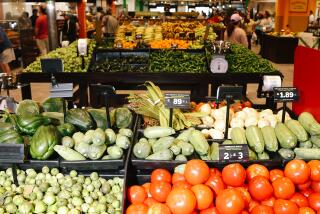Farmers Markets: Santa Barbara Pistachio Co.’s green nuts popping up
- Share via
VENTUCOPA, Calif. — Pistachios are available from storage year-round, but for the next week or so, ultra-seasonal green nuts, freshly harvested and still encased in their hulls, will appear at farmers markets. Moister, softer and sweeter than regular pistachios, they have their own flavor that hints at citrus and eucalyptus. They are sold by Santa Barbara Pistachio Co., owned by the Zannon family, who started last Sunday to harvest 400 acres in the remote, pristine Cuyama Valley, midway between Santa Barbara and Bakersfield.
The terrain is starkly gorgeous, and propitious for pistachios: the 3,000-foot elevation, fresh breezes, low humidity and winter cold reduce the pressures from pests and diseases and make it easier for the Zannons to grow organically. There are corresponding challenges: pistachio trees grow more slowly than in the San Joaquin Valley, where the vast majority of the state’s 154,000 acres of pistachios are cultivated. In Cuyama there are just 1,000 acres of pistachio trees, which are often zapped by late freezes during bloom, so the average yield is lower.
“We’ve lost four crops in the last 10 years,” said farm manager Tristan Zannon, 37. “We don’t get a lot of sleep in April.”
It’s frantic for him too in mid-October, when the nuts start popping open on the trees. For about 12 days, four teams of harvest machines shake the nuts off onto tarps. Just a few are sold as green nuts, which are highly perishable; the rest must be processed within a day, to avoid undesirable staining of the shells and kernels. A plant in Lost Hills rubs the moist, fibrous hulls off the nuts and dries them down to about 8% moisture. These are “raw” pistachios, which account for just 5% of sales for the Zannons. Most of their crop is stored in Bakersfield and trucked back to Cuyama throughout the year for roasting and flavoring in small batches.
Last year was a light harvest for the Zannons, so they are almost out of the old crop and will start selling the new crop in the next week or two. It’s not clear, however, that there’s much difference in flavor between old- and new-crop pistachios.
“Roasting time is really when you start the clock on pistachios,” said Josh Zannon, Tristan’s brother, who is in charge of processing. He and their mother, Gail, have developed nine flavors, such as habanero and onion garlic, as well as pistachio oil, butter and ground meal.
Native to Asia Minor and Western Asia, pistachios were introduced to California in 1854, but were not farmed commercially until the 1960s and ‘70s, after the release of a new, well-adapted variety, Kerman, and the mechanization of harvest. Pistachio cultivation really surged after 1979, when an embargo of nuts from Iran, then the world’s dominant producer, provided a huge boost to the domestic industry. Demand from export markets continues to grow, and pistachio cultivation has been highly profitable and fast growing in recent years. California raises more than 98% of the domestic crop, and the United States now equals or exceeds Iranian production, said Bob Klein, manager of the Administrative Committee for Pistachios.
Kerman, named after a province in eastern Iran where its seed parent originated, virtually monopolizes California pistachio cultivation, along with a sprinkling of male trees for pollination. Kerman is dominant because it blooms late and bears heavy crops of large, attractive nuts, which split well and are easy to harvest. It’s not perfect, however, because its trees are strongly alternate bearing, and their nuts’ flavor is mild compared with the best European and Asian varieties. The danger of the Kerman monoculture is that if new pests or diseases threaten pistachio orchards, the lack of genetic diversity will make it more difficult for the industry to find resistant varieties.
Gene Zannon, 67, grew up in Bakersfield and Santa Monica, moved to Santa Barbara and prospered in the direct mail business. He and his wife, Gail, a former dancer for American Ballet Theatre in New York, loved the spare beauty of Cuyama, and started planting pistachios there in 1991.
Drawing upon their expertise in marketing, the Zannons named the farm Santa Barbara Pistachio Co. “because Santa Barbara is famous, and no one has heard of Cuyama,” said Gail. The farm is in fact located at the extreme northeastern corner of Santa Barbara County, close to its borders with Ventura, Kern, and San Luis Obispo counties. It’s almost surrounded by the Los Padres National Forest, where cougars roam and condors soar.
Son Tristan (so-named because his mother is a Wagner aficionado) interned with pistachio scientists at the University of California research station at Kearney and took over direction of the farm’s production in 2004, gradually converting it to certified organic practices. Only a very small portion of the state’s pistachio production is organic (1,200 acres, estimates Tristan), so organic nuts bring a considerable premium over conventional, which helps make up for the lower yields in Cuyama.
The Zannons’ green nuts will be available, three pounds for $7, through Oct. 28, at Santa Monica on Saturday and Wednesday; at Hollywood, Mar Vista, and Ojai on Sunday; and at Santa Barbara on Saturday and Tuesday. They should be refrigerated immediately because the hulls spoil and discolor quickly. Middle Easterners do make traditional preserves from the hulls, but for the most part they are discarded.
Joshua Drew, executive chef of Farmshop, bought four bags of green pistachios on Wednesday at Santa Monica, deep-fried the nuts, hulled but still in their shells, and dressed them with dry harissa powder, fresh lime zest and juice. They “retain a lot of their moisture, so they get crispy and literally caramelize around the outside of the nut, but remain really fluffy and light inside,” he said.
More to Read
Eat your way across L.A.
Get our weekly Tasting Notes newsletter for reviews, news and more.
You may occasionally receive promotional content from the Los Angeles Times.










